Policymakers need to rethink the war on tobacco
Our lawmakers are on a mission –– they want to end what they have termed a public health crisis– tobacco use. To this point, Governor Walz proposed tax hikes on cigarettes–– that he later withdrew–– as well on vaping products. In this legislative session, similar bills were introduced to raise taxes on tobacco products as well as ban flavored tobacco products –– including e-cigarettes and other vaping products. But are these proposals the magic bullet to tobacco use that lawmakers proclaim them to be? A new report by the Center of the American Experiment shows otherwise.
Tax hikes have little impact on tobacco use
Smoking and tobacco use has generally been on a decline in Minnesota. Between 2000 and 2020, cigarette use declined by 90.1 percent among high school students and 78.0 percent among middle school students. Even after accounting for e-cigarettes, reported use of tobacco products among the youth was significantly down in 2020 – 20.5 percent among high school students and 4.1 percent among middle school–, compared to 2000’s rates of 38.7 percent and 12.6 percent. This is a trend that has been observed nationwide and bears very little correlation with cigarette tax hikes.
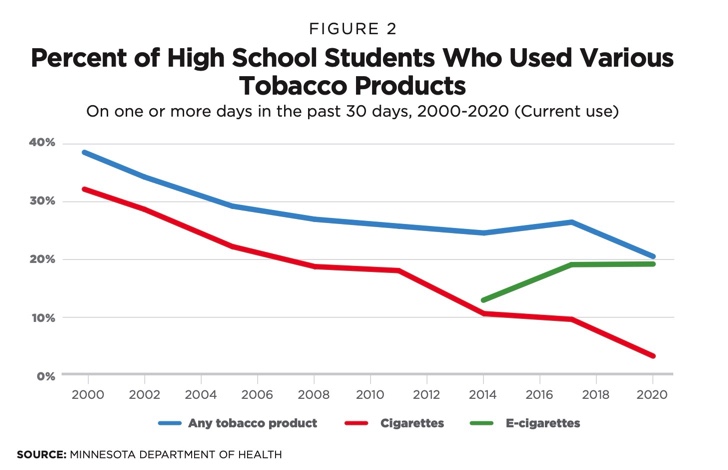
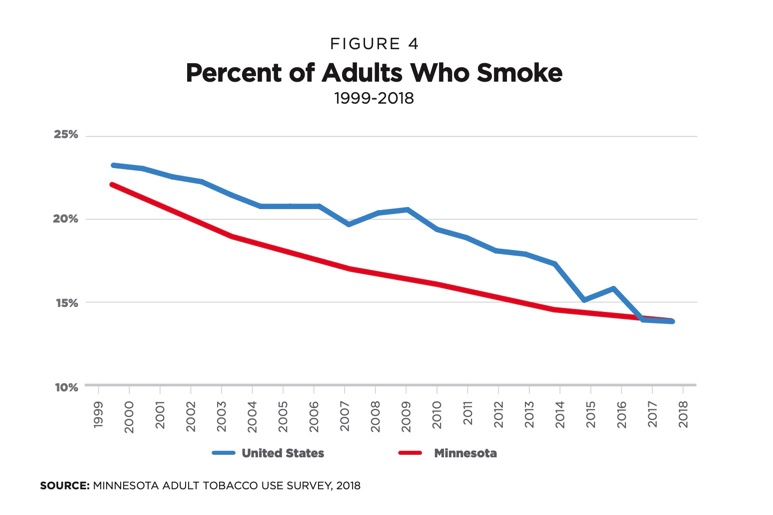
The truth is that tax hikes have very little impact on tobacco use because regular and long-term use is much more common among disadvantaged groups, like people with mental health or low socio-economic status who are less likely to respond to high prices and therefore less likely to quit. People with mental health issues, for instance, have 2 times the state-wide average smoking rate in Minnesota.
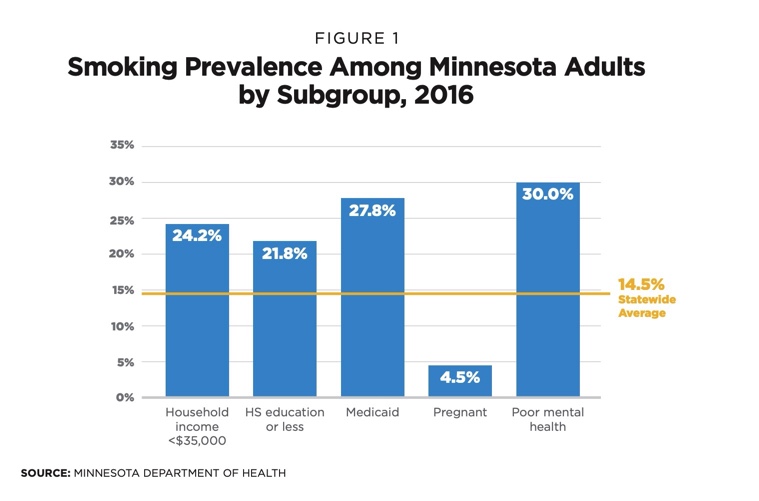
High taxes = Increased Smuggling
High taxes, however, encourage smuggling as tax differentials present profit opportunities, which hurts our convenience stores. Cigarettes smuggled into Minnesota adhere to no regulations and face no tax burden, harming legitimate businesses, and losing the state potential tax revenue as well as economic activity.
In 2018, Minnesota had the 5th highest cigarette tax rate per pack in the country and ranked 5th on cigarette smuggling– 36% of cigarettes smoked in Minnesota were smuggled in from other states. Between 2006 and 2018 Minnesota faced a 52% increase in smuggling. Coincidentally, excise taxes had grown 142% during the same period. The relationship between taxes and smuggling is very well documented.
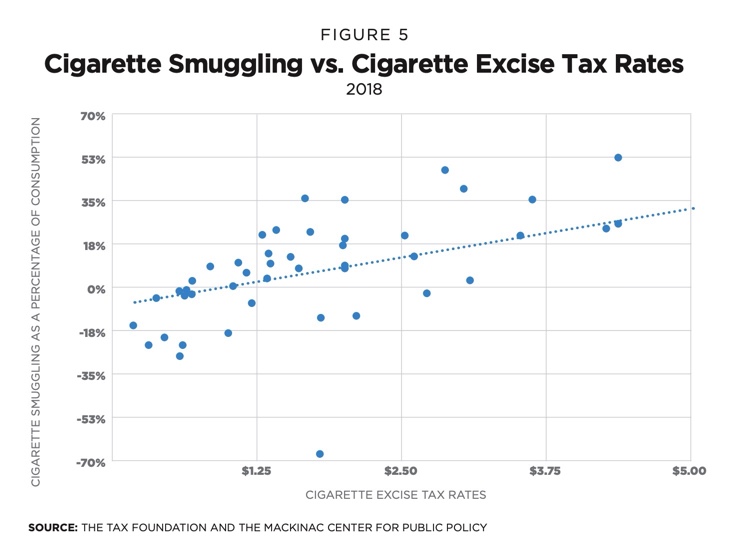
Currently, the total tax rate on cigarettes in Minnesota –– $3.673 –– is about eight times higher than that of North Dakota –– $0.44. It would be irrational for our policymakers to not expect a tax hike to push Minnesotans into buying their cigarettes in North Dakota or any of our other three neighbors that happen to have lower excise taxes. That is what happened after Minnesota raised the cigarette excise tax in 2013. Border communities saw a significant decline in cigarette sales as well as loss of sales in non-tobacco products that accompany tobacco products.
Tobacco taxes fall hardest on the poor
Notwithstanding, tobacco taxes also hurt the poor the most as they spend a higher proportion of their income on tobacco products and have higher rates of tobacco use than people with higher incomes. In 2018, Minnesotans with incomes of $35,000 or less had a smoking rate of 24.1 percent compared to 8.7 percent among people with incomes over $75,000. And in 2019, half of all smokers made $24,999 or less.
And according to the 2021 Tax Incidence tax study, in 2018, the 10 percent of Minnesotans with the lowest incomes paid an effective tax rate of 2.77 percent on tobacco products compared to the 0.05 percent paid by the 10 percent with the highest incomes. Policymakers risk further burdening low-income individuals by raising taxes on tobacco.
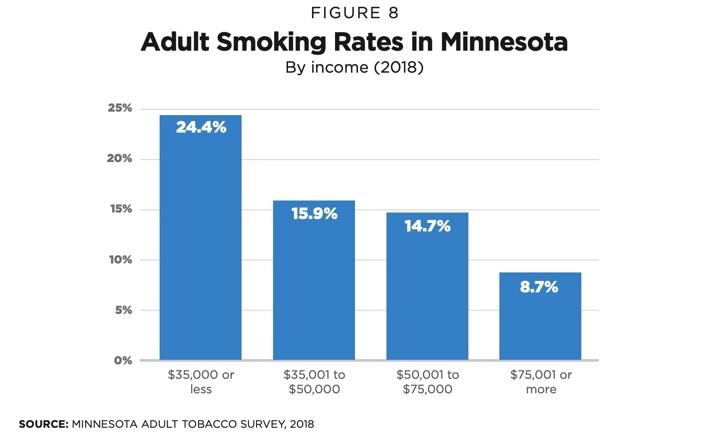
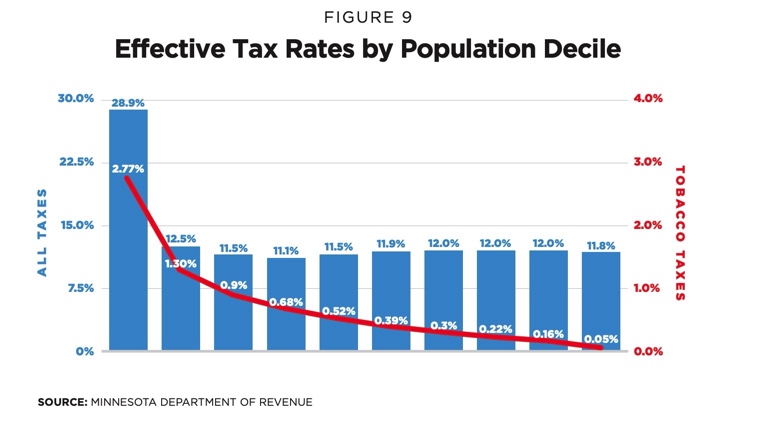
Vaping restrictions increase cigarette use
If the goal is to indeed protect public health, lawmakers need to rethink policies that merely burden smokers with high taxes–– of which the majority of revenue goes toward the general fund and not smoking prevention or cessation program –– and harm businesses but have no discernible effect on tobacco use.
Research has found e-cigarettes and other vaping products to be up to 95% less harmful than cigarettes, and they help smokers quit using cigarettes. Improving access to these products could be a good way to reduce smoking-related diseases and death caused by toxins in harmful tobacco products.
Generally, regular e-cigarette use among the youth is rare but heavily coincides with reduced cigarette smoking. Policies that restrict access to these products –– like the ones proposed –– are counterproductive and will harm public health by pushing more people –– especially the youth–– into smoking more cigarettes.